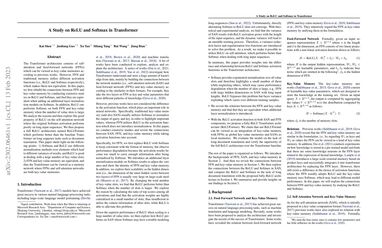A Study on ReLU and Softmax in Transformer
The Transformer architecture consists of self-attention and feed-forward networks (FFNs) which can be viewed as key-value memories according to previous works. However, FFN and traditional memory utilize different activation functions (i.e., ReLU and Softmax respectively), which makes them not equivalent. In this paper, we first rebuild the connections between FFN and key-value memory by conducting extensive studies on ReLU and Softmax, and find they are equivalent when adding an additional layer normalization module on Softmax. In addition, ReLU outperforms Softmax on both FFN and key-value memory when the number of value slots is large. We analyze the reasons and then explore this good property of ReLU on the self-attention network where the original Softmax activation performs poorly on long input sequences. We then propose a full ReLU architecture named ReLUFormer which performs better than the baseline Transformer on long sequence tasks such as document translation. This paper sheds light on the following points: 1) Softmax and ReLU use different normalization methods over elements which lead to different variances of results, and ReLU is good at dealing with a large number of key-value slots; 2) FFN and key-value memory are equivalent, and thus the Transformer can be viewed as a memory network where FFNs and self-attention networks are both key-value memories.
PDF Abstract
